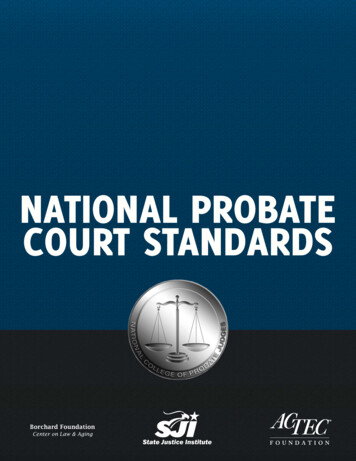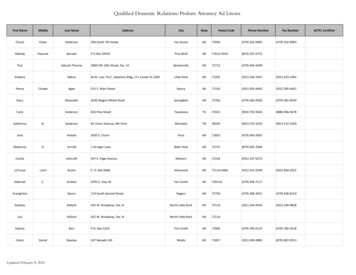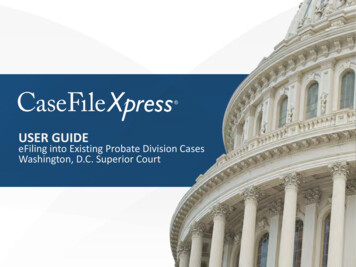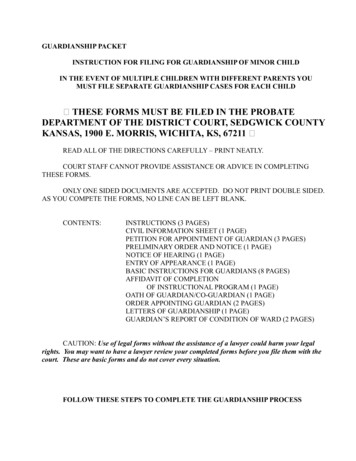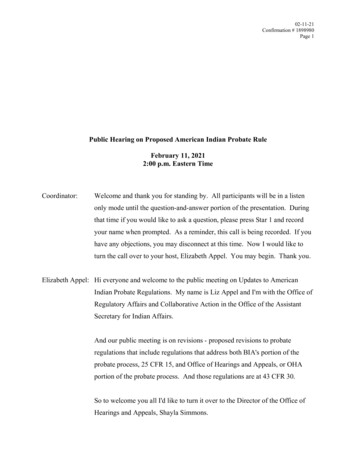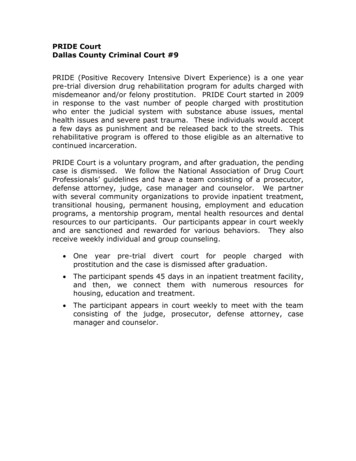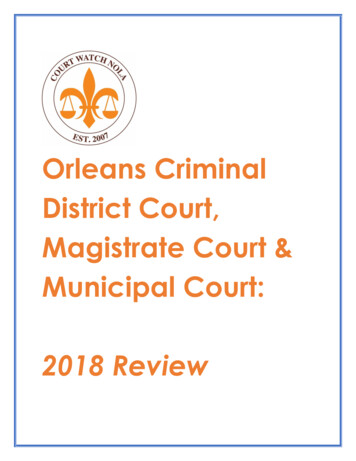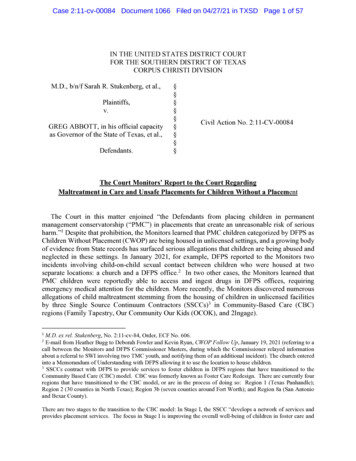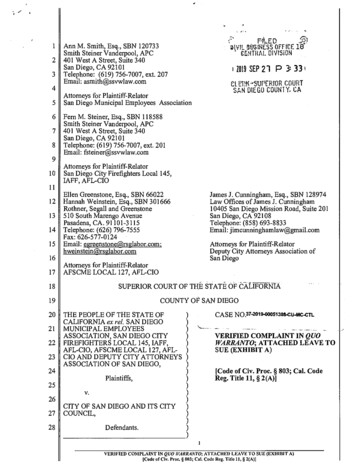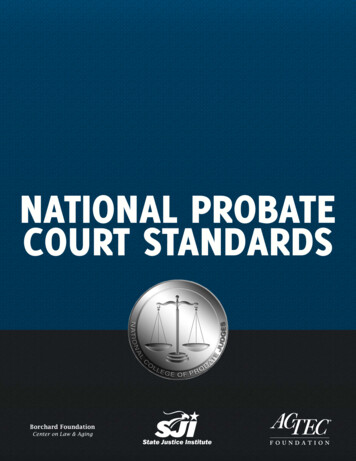
Transcription
NATIONAL PROBATECOURT STANDARDSBorchard FoundationCenter on Law & AgingA
IntroductioniTASK FORCE ON REVISION OFTHE NATIONAL PROBATECOURT STANDARDSMARY JOY QUINN, President, National College of Probate Judges (2010-2011),Director (ret.), Probate, Superior Court, San Francisco, CAHON. TAMARA CURRY, Executive Committee, National College of Probate Judges (2010-2012),Associate Judge, Probate Court, Charleston, SCANNE MEISTER, Register of Wills, Probate Division, Superior Court, Washington, DCHON. WILLIAM SELF, President, National College of Probate Judges (2011-2012),Judge, Probate Court, Macon, GAHON. JEAN STEWART, Secretary-Treasurer, National College of Probate Judges (2010-2012),Judge (ret.), Probate Court, Denver, COHON. MIKE WOOD, President, National College of Probate Judges (2012-2013), Judge, Probate Court No. 2, Houston, TXKEVIN BOWLING, President, National Association for Court Management (2011-2012),Court Administrator, 20th Judicial Circuit Court, Ottawa County, MIJUDE DEL PREORE, President, National Association for Court Management (2010-2011),Trial Court Administrator, Superior Court, Mount Holly, NJPROF. MARY RADFORD, President, American College of Trust and Estate Counsel (2011-2012),Georgia State University College of Law, Atlanta, GAROBERT SACKS, Esq., American Bar Association Section on Real Property, Trust and Estate Law, Los Angeles, CA,RICHARD VAN DUIZEND, Standards Reporter, National Center for State CourtsBRENDA K. UEKERT, Ph.D., Standards Research Director, National Center for State CourtsACKNOWLEDGMENTSThis volume is the result of a long-term collaborative effort involving many individuals and organizations. The Reporter and ResearchDirector would like to extend their deep appreciation to: iThe Board of the Directors of the National College of ProbateJudges for their vision and commitment to excellence whenagreeing to undertake this revision effort and the members ofNCPJ for their consideration and supportThe State Justice Institute, the Borchard FoundationCenter on Law and Aging, and the ACTEC Foundationfor their generous funding support and their patience andencouragement during the lengthy revision processThe members of the Task Force on Revision of the NationalProbate Court Standards representing the National Collegeof Probate Judges; the National Association for CourtManagement; the American Bar Association Section onReal Property, Trust, and Estate Law, and the AmericanCollege of Trust and Estate Counsel, for their dedication,thoughtfulness, openness, and kindness throughout thedrafting processThe “Observers”, particularly Professor David English, forgiving so generously of their time and expertise to enableus to “get it right” The members of the Commission on National ProbateCourt Standards and its staff that produced the originalNational Probate Court Standards which provided such asolid base on which to buildThe many individuals and organizations that painstakinglyread through the Review Draft and suggestedenhancements, clarifications, suggestions, and correctionsthat have greatly improved these standards including butnot limited to the American Bar Association Section onReal Property, Trust, and Estate Law; Frederick D. Floreth,President of the Center for Guardianship Certification;Cherstin Hamel, Assistant Director, Judicial ProgramsDepartment, of the Administrative Office of PennsylvaniaCourts; Sally Hurme; the National Council of Juvenile andFamily Court Judges; and Professor Winsor Schmidt; EricaWood, Assistant Director of the American Bar AssociationCommission on Law and Aging; NCJFCJOur colleagues at the National Center for State Courts,including our many law student assistants, for their hardwork and unstinting support.
NATIONAL PROBATECOURT STANDARDSNational College of Probate Court JudgesRichard Van DuizendBrenda K. UekertReporterResearch DirectorBorchard FoundationCenter on Law & AgingThis document has been prepared under an agreement between the National College of Probate Judges through the National Centerfor State Courts supported through Grant No. SJI-10-T-180 from the State Justice Institute and grants from the Borchard FoundationCenter on Law and Aging and the ACTEC Foundation. The points of view and opinions offered in this report are those of the TaskForce on Revision of the National Probate Court Standards and do not necessarily represent the official policies or position of the StateJustice Institute, the Borchard Foundation Center on Law and Aging, ACTEC Foundation, or the National Center for State Courts.Design and layout byOnline legal research provided byii
IntroductioniiiTABLE OF CONTENTS1iiiINTRODUCTION99121316SECTION 1: PRINCIPLES FOR PROBATE COURT PERFORMANCE1.1 ACCESS TO JUSTICE1.2 EXPEDITION AND TIMELINESS1.3 EQUALITY, FAIRNESS, AND INTEGRITY1.4 INDEPENDENCE AND ACCOUNTABILITY18181919SECTION 2: ADMINISTRATIVE POLICIES AND PROCEDURES OF THE PROBATE COURT2.1 JURISDICTION AND RULEMAKING2.1.1 JURISDICTION2.1.2 RULEMAKING202022232.2CASEFLOW MANAGEMENT2.2.1 COURT CONTROL2.2.2 TIME STANDARDS GOVERNING DISPOSITION2.2.3 SCHEDULING TRIAL AND HEARING DATES24242426262.3JUDICIAL LEADERSHIP2.3.1 HUMAN RESOURCES MANAGEMENT2.3.2 FINANCIAL MANAGEMENT2.3.3 PERFORMANCE GOALS AND STRATEGIC PLAN2.3.4 CONTINUING PROFESSIONAL EDUCATION COMMENTARY272829302.4INFORMATION AND TECHNOLOGY2.4.1 MANAGEMENT INFORMATION SYSTEM2.4.2 COLLECTION OF CASELOAD INFORMATION2.4.3 CONFIDENTIALITY OF SENSITIVE INFORMATION30302.5ALTERNATIVE DISPUTE RESOLUTION2.5.1 REFERRAL TO ALTERNATIVE DISPUTE RE SOLUTION323232343636383939SECTION 3: PROBATE PRACTICES AND PROCEEDINGS3.1 COMMON PRACTICES AND PROCEEDINGS3.1.1 NOTICE3.1.2 FIDUCIARIES3.1.3 REPRESENTATION BY A PERSON HAVING SUBSTANTIALLY IDENTICAL INTEREST3.1.4 ATTORNEYS’ AND FIDUCIARIES’ COMPENSATION3.1.5 ACCOUNTINGS3.1.6 SEALING COURT RECORDS3.1.7 SETTLEMENT AGREEMENTS40404141423.2 DECEDENT’S ESTATES3.2.1 UNSUPERVISED ADMINISTRATION3.2.2 DETERMINATION OF HEIRSHIP3.2.3 TIMELY ADMINISTRATION3.2.4 SMALL ESTATES
TABLE OF 3.3PROCEEDINGS REGARDING GUARDIANSHIP AND CONSERVATORSHIP FOR ADULTS3.3.1 PETITION3.3.2 INITIAL SCREENING3.3.3 EARLY CONTROL AND EXPEDITIOUS PROCESSING3.3.4 COURT VISITOR3.3.5 APPOINTMENT OF COUNSEL3.3.6 EMERGENCY APPOINTMENT OF A TEMPORARY GUARDIAN/CONSERVATOR3.3.7 NOTICE3.3.8 HEARING3.3.9 DETERMINATION OF INCAPACITY3.3.10 LESS INTRUSIVE ALTERNATIVES3.3.11 QUALIFICATIONS AND APPOINTMENTS OF GUARDIANS AND CONSERVATORS3.3.12 BACKGROUND CHECKS3.3.13 ORDER3.3.14 ORIENTATION, EDUCATION, AND ASSISTANCE3.3.15 BONDS FOR CONSERVATORS3.3.16 REPORTS3.3.17 MONITORING3.3.18 COMPLAINT PROCESS3.3.19 ENFORCEMENT OF ORDERS; REMOVAL OF GUARDIANS AND CONSERVATORS3.3.20 FINAL REPORT, ACCOUNTING, AND DISCHARGE7677777879803.4INTERSTATE GUARDIANSHIPS AND CONSERVATORSHIPS3.4.1 COMMUNICATION AND COOPERATION BETWEEN COURTS3.4.2 SCREENING, REVIEW, AND EXERCISE OF JURISDICTION3.4.3 TRANSFER OF GUARDIANSHIP OR CONSERVATORSHIP3.4.4 RECEIPT AND ACCEPTANCE OF A TRANSFERRED GUARDIANSHIP3.4.5 INITIAL HEARING IN THE COURT ACCEPTING THE TRANSFERRED INGS REGARDING GUARDIANSHIP AND CONSERVATORSHIP FOR MINORS3.5.1 PETITION3.5.2 NOTICE3.5.3 EMERGENCY APPOINTMENT OF A TEMPORARY GUARDIAN/CONSERVATOR FOR A MINOR3.5.4 REPRESENTATION FOR THE MINOR3.5.5 PARTICIPATION OF THE MINOR IN THE PROCEEDINGS3.5.6 BACKGROUND CHECKS3.5.7 ORDER3.5.8 ORIENTATION, EDUCATION, AND ASSISTANCE3.5.9 BONDS FOR CONSERVATORS OF MINORS3.5.10 REPORTS3.5.11 MONITORING, MODIFYING, TERMINATING A GUARDIANSHIP OR CONSERVATORSHIP OF A MINOR3.5.12 COMPLAINT PROCESS3.5.13 COORDINATION WITH OTHER COURTSNATIONAL PROBATE COURT STANDARDSiv
IntroductionEvolution of Probate CourtsAlthough individual cases involving traditional probate matters such as wills, decedents’ estates, trusts, guardianships, andconservatorships have garnered considerable public and professional attention, relatively little attention has been focused untilrecently on the courts exercising jurisdiction over these cases. Unlike other types of courts (e.g., criminal courts), the evolutionof probate courts has differed considerably from state to state.In England, probate court jurisdiction began in the separate ecclesiastical courts and the courts of chancery. The early probatecourts in America exercised equity jurisdiction. Modern counterparts of these equity courts are chancery, surrogate, andorphan’s courts. In other American jurisdictions, a judge within a court of broader jurisdiction would typically be givenresponsibility for probate cases (usually in addition to other duties) because of that judge’s expertise or interest in the area or toexpedite the handling of this group of cases. Over time, this caseload became sufficiently large to necessitate the assignment offull-time probate judges or the establishment of a separate probate court in some jurisdictions.This evolution, however, occurred differently in every state, and even within different jurisdictions within a given state. As a result, thereis considerable variation between (and often within) the various states in the way in which the state courts handle probate matters.Need for National Probate Court StandardsThis evolution has provided little opportunity for the development of uniform practices by courts exercising probate jurisdiction.Meanwhile, a call for the study of probate court procedures has come from both within and outside the probate courts,including judicial leaders and organizations, bar associations, academicians, and the public. The administration, operation, andperformance of courts exercising probate jurisdiction have been identified as areas in need of attention.In 1987, after numerous stories of abuses, the Associated Press (AP) conducted a study of the nation’s guardianship/conservatorshipsystem, resulting in a report, “Guardians of the Elderly: An Ailing System.” The report described a “dangerously burdened andtroubled system that regularly puts elderly lives in the hands of others with little or no evidence of necessity, and then fails to guardagainst abuse, theft, and neglect.” Specifically identified problems were lack of resources to adequately monitor the activities ofguardians/conservators and the financial and personal status of their wards; guardians/conservators who have little or no training; lackof awareness of alternatives to guardianship/conservatorship; and the lack of due process.1Active involvement in guardianship/conservatorship issues provided the foundation for the sponsorship by the American BarAssociation (ABA) of the 1988 Wingspread National Guardianship Symposium. Experts from across the country attendedthe meeting, including probate judges, attorneys, guardianship and conservatorship service providers, doctors, aging networkrepresentatives, mental health experts, government officials, law professors, a bioethicist, a state court administrator, ajudicial educator, an anthropologist, and ABA staff. The symposium produced recommendations for reform of the nationalguardianship/conservatorship system, which were largely adopted by the ABA’s House of Delegates in February 1989. Therecommendations, especially those pertaining to judicial practices, reflected the need for improvement of practices and1Associated Press, Guardians of the Elderly: An Ailing System (Special Report, September 1987). See also Fred Bayles & Scott McCartney, Declared“Legally Dead”: Guardian System is Failing the Ailing Elderly, The Record (September 20, 1987); American Bar Association, Guardianship: AnAgenda For Reform (1989).1
NATIONAL PROBATE COURT STANDARDSprocedures related to guardianship/conservatorship in probate courts.2 These initial examinations of the exploitation, neglect,and/or abuse of persons under guardianship or conservatorship have been followed by additional articles in the press,3government and private studies,4 state task forces,5 and sets of national recommendations.6Efforts to reform the administration of decedents’ estates predate guardianship reform. A Model Probate Code was promulgatedin 1946 and provided the basis for reform in the 1950s and 1960s. In 1969, the National Conference of Commissioners on UniformState Laws and the ABA approved the Uniform Probate Code (UPC), which was drafted by which was jointly drafted by theCommissioners and by the ABA Section of Real Property, Probate and Trust Law. The UPC has been adopted by 18 jurisdictions,and has been adopted in part or has influenced reform in still others.7 It has been revised numerous times since 1969, most recentlyin 2008, and has been followed by related uniform legislation such as the Uniform Guardianship and Protective Proceedings Act, theUniform Guardianship and Protective Proceedings Jurisdiction Act, and the Uniform Trust Code.8The need for reform of courts exercising probate jurisdiction has been expressed not only by those outside of the courts but also bythe court leadership itself. In 1990, in order to determine the need for national probate court standards and to assess the supportfor a project to develop such standards, the National College of Probate Judges (NCPJ) and the National Center for State Courts(NCSC) polled 42 state representatives of the NCPJ. Responses were received from 30 of these representatives and four state courtadministrators in states that do not have separate probate courts or probate divisions of general or limited jurisdiction courts.The overwhelming number of respondents stated that current standards, including those of the ABA, did not sufficiently addressthe concerns of probate courts. Twenty-seven (79%) of the 34 respondents cited the need for separate probate court standards.Recommendations for improved judicial practices include removal of barriers, use of limited guardianship/conservatorship and other less intrusivealternatives, creative use of non-statutory judicial authority, and enhanced judicial role in providing effective legal representation. American BarAssociation, supra, note 1, at 19-223See e.g., Paul Rubin, Checks & Imbalances: How the State’s Leading Private Fiduciary Helped Herself to the Funds of the Helpless, Phoenix New Times(June 15, 2000); Carol D. Leonnig et al., Misplaced Trust/Guardians in the District: Under Court, Vulnerable Become Victims, The Washington Post,(June 15-16, 2003); S. Cohen et al., Misplaced Trust: Guardians in Control, The Washington Post, (June 16, 2003); Kim Horner, Lee Hancock, Holes in theSafety Net, Dallas Morning News (January 12, 2005); S.F. Kovalski, Mrs. Astor’s Son to Give Up Control of Her Estate, The New York Times, (October 14,2006); Robin Fields, Evelyn Larrubia, Jack Leonard, “Justice Sleeps While Seniors Suffer,” Los Angeles Times (November 14, 2005); Kristin Stewart, SomeAdults’ ‘Guardians’ Are No Angels, The Salt Lake Tribune, (May 14, 2006); Cheryl Phillips, Maureen O’Hagan and Justin Mayo, Secrecy Hides Cozy Ties inGuardianship Cases, Seattle Times (December 4, 2006); P. Kossan and R. Anglen, Task Force to Probe Arizona Probate Court, The Arizona Republic (May. 4,2010); Todd Cooper, Ward’s Assets Vulnerable, Omaha World Herald (August 16, 2010).4See e.g., Sen. Gordon.H. Smith & Sen. Herbert. Kohl, Guardianship for the Elderly: Protecting the Rights and Welfare of Seniors with Reduced Capacity (US Senate Special Committee on Aging, December 2007); Government Accountability Office, Guardianships: Cases of Financial Exploitation, Neglect,and Abuse of Seniors (GAO-10-1046, 2010); David. C. Steelman, Alicia. K. Davis, Daniel. J. Hall, Improving Protective Probate Processes: An Assessmentof Guardianship and Conservatorship Procedures in the Probate and Mental Health Department of the Maricopa County Supreior Court (NCSC, July2011); Pamela B. Teaster, Erica F. Wood, Naomi Karp, Susan A. Lawrence, Winsor.C. Schmidt, Jr., Marta S. Mendiondo, Wards of the State: A NationalStudy of Public Guardianship (2005); Oversight of Probate Cases: Colorado Judicial Branch Performance Audit, (Colorado Legislative Audit Committee,2006); Naomi Karp & Erica Wood, Guardianship Monitoring; A National Survey of Court Practices (AARP 2006); Ellen M. Klem, Volunteer GuardianshipMonitoring Programs: A Win-Win Solution (ABA Commission on Law and Aging 2007); Pamela B. Teaster, Winsor C. Schmidt, Jr., Erica. F. Wood, SusanA, Lawrence, & Marta Mendiondo, Public Guardianship: In the Best Interest of Incapacitated People? (Praeger Publishers, 2007); Judicial Determination ofCapacity of Older Adults in Guardianship Proceedings (ABA Commission on Law and Aging, American Psychological Association, National College of Probate Judges 2006); Naomi Karp and Erica Wood, Guarding the Guardians: Promising Practices for Court Monitoring (AARP 2007); Brenda.Uekert, AdultGuardianship Court Data and Issues: Results from an Online Survey (NCSC 2010).5See e.g., Ad hoc Committee on Probate Law and Procedure, Final Report to the Utah Judicial Council (February 23, 2009); Joint Review Committee on the Statusof Adult Guardianships and Conservatorships in the Nebraska Court System, Report of Final Recommendations (2010); Committee on Improving Judicial Oversightand Processing of Probate Court Matters, Final Report to the Arizona Judicial Council (2011).2Third National Guardianship Summit: Standards of Excellence, Guardian Standards and Recommendations for Action, 2012 Utah L. Rev. No. 3, 1191(2013); Conference of State Court Administrators (COSCA), The Demographic Imperative: Guardianships and Conservatorships, 8 (December 2010).Recommendations, Wingspan – The Second National Guardianship Conference 31 Stetson Law Review 595 (2002); National Guardianship Network,National Wingspan Implementation Session: Action Steps on Adult Guardianship Progress (2004); Jeanne. Dooley, Naomi. Karp, Erica. Wood, Opening theCourthouse Door: An ADA Access Guide for State Courts (1992); Court-Related Needs of the Elderly and Persons with Disabilities: A Blueprint for theFuture (American Bar Association and National Judicial College, 1991).7http://www.uniformlaws.org/Act.aspx?title Probate Code.8http://www.uniformlaws.org/Act.aspx?title Guardianship and Protective Proceedings Act; http://www.uniformlaws.org/Act.aspx?title Adult Guardianship andProtective Proceedings Jurisdiction Act; http://www.uniformlaws.org/Act.aspx?title Trust%20Code.62
Introduction3Even those who did not advocate special probate court standards believed that guidance in some areas, such as automated caseprocessing, would be helpful to probate courts. Most respondents believed that national probate standards were needed in theareas of fees and commissions, court automation, judicial education, judicial officer and support staff, and financial and fundmanagement, and to address the performance of courts exercising probate jurisdiction.In sum, the need for reform and improvement of the administration, operations, and performance of courts exercising probatejurisdiction has been clearly expressed by groups and individuals both inside and outside of these courts.Accordingly, the NCPJ, in cooperation with the NCSC, undertook a two-year project in 1991 to develop, refine, disseminate, andpromulgate national standards for courts exercising probate jurisdiction—the National Probate Court Standards Project. Supportwas provided by a grant from the State Justice Institute, with a supplemental grant provided by the American College of Trust andEstate Counsel Foundation. The standards were intended to provide a common language to facilitate description, classification, andcommunication of probate court activities; and, most importantly, a management and planning tool for self-assessment and selfimprovement of courts throughout the country exercising probate jurisdiction.The National Probate Court Standards were prepared by a 15-member Commission on National Probate Court Standards(Commission) chaired by Hon. Evans V. Brewster of New York, then President of N
THE NATIONAL PROBATE COURT STANDARDS. MARY JOY QUINN, President, National College of Probate Judges (2010-2011), Director (ret.), Probate, Superior Court, San Francisco, CA . HON. TAMARA CURRY, Executive Committee, National College of Probate Judges (2010-2012), Associate Judge,
